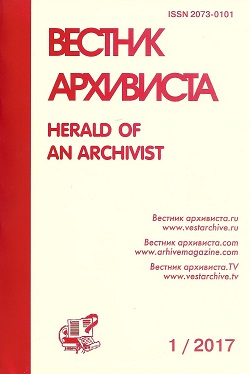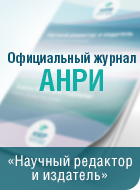Socio-political composition of precinct commissions for elections to the All-Russian Constituent Assembly in November 1917. Based on the materials of Kaluga Province



Scientific article
doi 10.28995/2073-0101-2024-3-794-809
For citation
Mukhina, Marina V. (2024), Socio-political composition of precinct commissions for elections to the All-Russian Constituent Assembly in November 1917. On the materials of Kaluga province, Herald of an Archivist, № 3, pp. 794-809, doi 10.28995/2073-0101-2024-3-794-809
Mukhina, Marina V., Kaluga State University, Kaluga, Russia
Socio-political composition of precinct commissions for elections to the All-Russian Constituent Assembly in November 1917. Based on the materials of Kaluga Province
Abstract
The author undertakes a source analysis of the document found in the State Archive of the Russian Federation (GARF). On its basis he reconstructs the socio-political composition of the grassroots units of the electoral system - precinct commissions. In the context of the growing political crisis, the responsible work of members of precinct commissions in counting votes and objectively reflecting the voting process seems particularly important. The article considers the composition of 103 out of 723 precinct commissions of 7 counties out of 11 in Kaluga province (Kaluga electoral district), which is 14% of the total number of precincts. Based on the content of the document under study, the author identified the following parameters for analyzing the socio-political composition of the commissions: gender, age, education, profession, nationality, party affiliation. The author uses the traditional historical and genetic method, as well as quantitative analysis methods to calculate data according to specified parameters. Despite the possibility for women to participate in political life under the new electoral legislation, this practice was new, especially for residents of the provinces. In this regard, the author found that in the Kaluga electoral district the share of women's participation in commissions was relatively small - 22%. Women were overwhelmingly involved in the commissions as the most literate people in the area and served as secretaries. All female commission members were teachers or were educated in this profession. Precinct commissions included people of different age categories (the youngest commission member was 20 years old, the oldest - 65 years old). The article shows that, contrary to the requirements of the electoral legislation, about 9% of the composition of the commissions were marked as illiterate, which can be explained by the lack of people willing to fulfill the duties of commission members. The largest professional group was peasants (59%), who made up the majority of the province's residents. Teachers, zemstvo employees, representatives of the clergy who had experience in local government and were the most literate category of residents made up 21% of members of precinct election commissions. Their party affiliation was indicated by 16% of the commission members, who identified themselves as members of the Socialist-Revolutionary Party (SR) or RSDLP(b). The low level of political culture was manifested in the attribution of the volost zemstvo to a political party, about 43% of the commission members noted “elected by the volost zemstvo”. For greater clarity, the data are formalized and presented in tables. The author concluded that the work of members of precinct commissions was less influenced by their party affiliation, as the general level of political culture of the population of the province was at a low level. The professional affiliation and level of education of commission members could play a greater role.
Keywords
All-Russian Constituent Assembly, Provisional Government, Kaluga Province, district commissions, socio-political composition, historical source.
Download the article: mukhina_doi
References
Akulshin, P. V. (2019), Elections to the Constituent Assembly and political struggle in the provinces of central Russia in 1917-1920 (on the materials of Vladimir, Kaluga, Ryazan and Tula provinces). IN: Tavricheskie readings 2018. Actual problems of parliamentarism: history and modernity. Collection of scientific articles, Ch. 2, Nikolaev, A. B. (ed.), Asterion, St. Petersburg, Russia, pp. 161-170.
Bazanov, S. N. (2018), Results of the elections to the Constituent Assembly in the active army in November 1917 (truth and fiction). IN: Society and power in Imperial Russia, the USSR and the modern Russian Federation, Materials of the international scientific conference dedicated to the memory of Doctor of Historical Sciences, Honored Scientist of the Russian Federation E. M. Shagin, MPGU, Moscow, Russia, pp. 117-125.
Bukhovets, O. G. (2023), Elections to the All-Russian Constituent Assembly on the territory of the Belarusian provinces: electoral statistics and new horizons of study, New Historical Bulletin, № 1 (75), pp. 35-48.
Vorobyev, A. A., Yakovitsky, O. Ch. (2015), Elections to the All-Russian Constituent Assembly on the territory of Rogachev and Cherikov uyezd of Mogilev province, Bulletin of Krasnodar University of the Ministry of Internal Affairs of Russia, № 2 (28), pp. 21-22.
Vtorushin, M. I. (2019), Siberian society and the All-Russian Constituent Assembly in the context of the crisis of the revolution of 1917, Omsk Scientific Bulletin, Series: Society. History. Modernity, № 3. pp. 22-30.
Gordeev, P. N. (2022), “The lodge of the Constituent Assembly”: “the master of the Russian land” and the former imperial theaters, Vestnik of Perm University. Series: History, № 1 (56), pp. 105-111.
Kalashnikov, V. V. (2021), Dissolution of the Constituent Assembly as a cause of civil war: pro et contra. IN: Tavricheskie readings 2020, Actual problems of parliamentarism: history and modernity, Collection of scientific articles, Part 2, Nikolaev, A. B. (ed.), Asterion, St. Petersburg, Russia, pp. 123-137.
Belova, I. B. (ed.) (2014), Kaluga region in the XX century: historical sketches, KGIMO, Kaluga, Russia, 416 p.
Korolkov, O. P. (2016), Elections to the Constituent Assembly in Pskov Province (1917), Pskov. Scientific and practical, historical and local lore journal, № 45, pp. 45-67.
Matveev, M. N., Turganova, O. V. (2019), Historical and legal aspects of the introduction of volost zemstvo by the Provisional Government, Vestnik of Samara University, Series: History, pedagogy, philology, № 2, pp. 7-10.
About the authors
Mukhina Marina V., Kaluga State University, Institute of History and Law, Department of History, graduate student, Kaluga, Russian Federation, 8-953-329-1078, This e-mail address is being protected from spambots. You need JavaScript enabled to view it
The article was received in the editorial office on 00.00.2023, recommended for publication on 20.06.2024.











